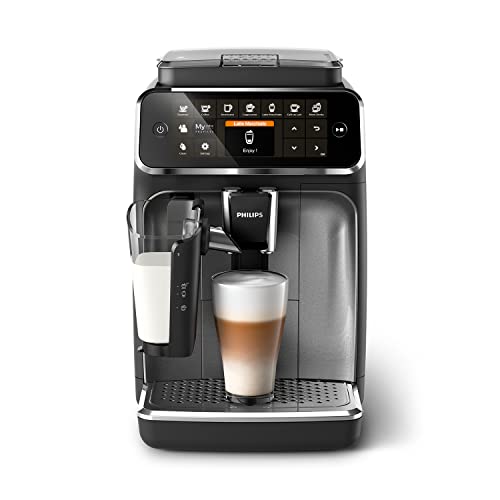Whole Bean Coffee Machine Beans
If your customers are conscious about their environmental impact they might be surprised to find out that whole bean coffee machines generate many waste products in the form of grounds.

Beans have a delicious flavor and can be stored for a long time in an airtight, dark container.
1. Roasted Beans
When coffee beans are first harvested they're green but they aren't suitable to make your morning cup until they've been roasted. Roasting is a sophisticated chemical process that transforms the raw beans into the deliciously flavored, aromatic coffee we drink every day.
There are several different roasts that determine the flavor and strength of the coffee that is brewed. The various roast degrees are determined by the length of time the beans are roasted for. They will also determine the amount of caffeine is present in the beverage.
Light roasts are roasted in the most quickly and are characterized with their light brown color. They also do not have oil on the beans. Around 350o-400o the beans begin to steam due to their internal water vapors that are released. The first crack will be heard shortly after. The first crack is a sign that beans will soon be ready to be brewed.
During roasting, sugars are caramelized and aromatic compounds form. These volatile and non-volatile compounds are the components that give coffee its distinctive aroma and taste. It is crucial not to roast the beans too much in this stage as they can lose their distinctive flavor or turn bitter. After roasting, the beans can be cooled using water or air.
2. Water Temperature
When brewing coffee, temperature of the water is one of the most important aspects. If the water is too hot, you'll risk over extraction, making the coffee bitter; too cold and you'll end up with weak or even unpalatable coffee. Use filtered or bottled coffee if necessary, and make sure to pre-heat your equipment prior to beginning to brew.
The more hot the water, the quicker it will dissolve things like flavor compounds and oils from the coffee grounds. The ideal temperature to brew coffee is between 195 and 205 degrees Fahrenheit. This is just below the boiling point. This temperature range is well-known among coffee professionals across the world and works well with most brewing methods.
However the exact temperature for brewing isn't always completely consistent since some of the heat is lost to evaporation in the process of brewing. This is especially relevant for manual methods like pour over and French press. Additionally, different brewing equipment may have different thermal mass and materials that can affect the final brew temperature.
In general, a hotter coffee brew will yield an espresso with more strength however, it is not always the case for all sensory characteristics. Some research has shown that chocolate, bitter and roast flavors are more intense when brewed at higher temperatures. Other tastes, like sweet, also diminish as temperatures rise.
3. Grind
Even the most excellent beans, perfect roast, and filtered fresh water may not yield an excellent cup of coffee if the grind isn't handled correctly. The size of the ground beans is a crucial factor in determining flavor strength, extraction rate and strength. It's crucial to have control over this aspect to try different recipes and maintain consistency.
The size of the bean after it was crushed is called the grind size. Different grind sizes are suitable for different methods of brewing. For instance, coarsely-ground coffee beans will make an espresso that is weak, while a finely-ground grind will produce an espresso that is bitter.
When selecting bean to cup coffee machine for coffee, it is vital to look for models that feature uniform grinding for maximum consistency. Burr grinders are the most efficient method to achieve this, and ensure that all coffee grounds are the same size. Blade grinders tend to be unreliable and could result in uneven grounds.
If you are looking to get the best out of your espresso maker, consider purchasing a machine with an integrated grinder and brewing unit. This will allow the beans to be brewed at their peak freshness and eliminate the requirement for ground coffee that has been pre-ground. Melitta Bialetti Mypresso offers all of these features in a sleek and modern package. It includes a range of recipes, 8 personalised user profiles and an app for smartphones for complete control. It has a dual-hopper and is compatible both with ground and whole beans.
4. Brew Time
If the brew duration is too short, you'll have a low extraction. It is possible to overextrusion if make your brew too long. This can cause bitter compounds to destroy the sweetness of sugars and flavors, and leave a bitter, sour taste in your drink.
If your coffee brewing time is excessively long, you'll lose the sweet spot for optimal extraction. This leads to weak coffee that is spongy and watery. It can be too acidic and unpleasant to drink. The ideal brewing time depends on the grind size and the amount of ground used, as well as the brewing method.
The top bean to cup machines tend to have a high-quality grinder with adjustable settings. This allows you to play around and find the perfect combination of brew time and water temperature for your favorite coffees.
The brewing process consumes more energy than any other component of the supply chain for coffee. Therefore, it is essential to know how to regulate the temperature of the brew in order to reduce waste and improve the taste. It is difficult to control the extraction with accuracy. This is due to the variation of particle sizes, the kinetics of dissolution, roasting and equipment, characteristics of the water, etc. This study evaluated TDS and analyzed PE to assess the impact of these variables on the taste profile of coffee. The TDS and PE values were low although there was some variation in the brews, possibly due to channelling.
